The Course of Empire
Symphony no. 1 for Symphony Orchestra
Instrumentation
3(3picc).3(EH).3(Eb Cl, BCl).3(Cb) 4.3.3(btn).1 hp pno timp+3perc str
Program Note
The Course of Empire is a cycle of five paintings by 18th century American painter Thomas Cole, founder of the Hudson River School. The cycle depicts the same landscape at different historical points of development of a fictional empire. The cycle was completed in 1836, and contains themes of man’s relationship to nature, development of civilization, excessive greed, and the vicissitudes of fortune. The cycle has been seen as a critical response to the election of populist president Andrew Jackson just a few years prior.
Cole drew direct inspiration from Lord Byron’s Childe Harold’s Pilgrimage, often citing the following lines in his descriptions and advertisements for the cycle:
There is the moral of all human tales;
‘Tis but the same rehearsal of the past.
First Freedom and then Glory—when that fails,
Wealth, vice, corruption—barbarism at last.
And History, with all her volumes vast,
Hath but one page.
The symphony is in five movements, each one corresponding to a painting. In it there are several musical motives analogous to themes in the paintings, all tied together by an expansive and imposing minor 7th interval heard in each movement, representing the large boulder atop a mountain seen in every painting, itself representing fate and inevitability. The famous Welsh hymn Calon Lân is quoted at various points, representing introspection, reflection, and a break from the aggressive ambition depicted. The first verse of this hymn is as follows:
I don’t ask for a luxurious life,
the world’s gold or its fine pearls,
I ask for a happy heart,
an honest heart, a pure heart.
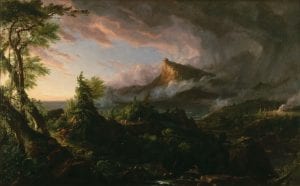
I. Ascension
Ascension, after Cole’s The Savage State, depicts a wild landscape inhabited by hunter-gatherers at daybreak just as a morning storm has blown over. The music captures both the grandiose and magical nature of a sunrise over an untouched earth, as well as the feverish efforts by early humans to carve out a place in the world for themselves, represented by a deer hunt. The large boulder sitting atop a mountain in the distance overlooks the scene.
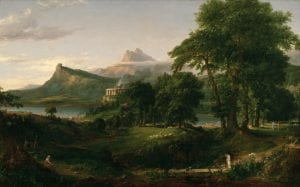
II. Pastorale
Pastorale, after Cole’s The Pastoral or Arcadian State, is depicted in a peaceful morning far into the future, as the land has been settled and cultivated. We see the beginnings of art and culture, as well as mathematics and agriculture. The scene is carefree and in harmony with nature.
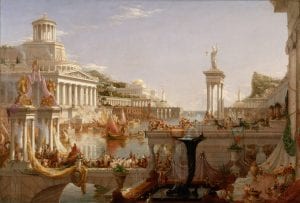
III. Apotheosis
Apotheosis, after Cole’s The Consummation of Empire, shows an expansive and ostentatious city, covered with grandiose marble statues, arches, and fountains. The scene is the largest of the five paintings, and takes place at midday during what appears to be a decadent parade (comparable to a Roman Triumph) attended by the city’s immense crowds. The boulder once prominent in the earlier scenes is now pushed far off into the background. The music charges along confidently, but is eventually overcome with a soft meditation contemplating the path the civilization is on. This, however, is short lived and we quickly return to the assertively patriotic revelry as we race to what appears to be a rousing finale.
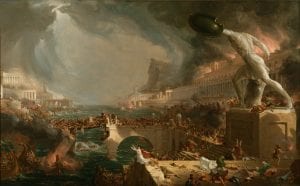
IV. Hubris
Hubris, after Cole’s Destruction, follows directly and abruptly after Apotheosis’ attempted happy ending. It begins with frightening drums, and dissonant calls of the fate motive from the brass. A terrifying afternoon tempest roars as an invading force burns the city to the ground in a violent sacking. The music, just as these scenes throughout history are, is relentless.
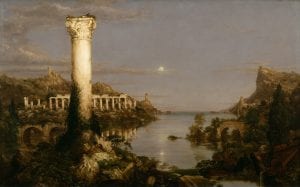
V. Ephemera
Ephemera, after Cole’s Desolation, emerges from the rubble with a lonely Viola tune, eventually and cautiously joined by other string sections accompanied sparsely by meandering twinkles in the harp, piano, and percussion. Occasionally we hear a distant conversation between two birds across the scene. Here we see the remains of the city, having been abandoned long ago and now being reclaimed by nature. We are in the early evening, and see the moon’s reflection glistening softly on the still water. The music is numb, desolate, at times pained, but eventually settles into a resolute and calm reprise of the sunrise theme falling gently into the music with which the symphony began. We hear a distant memory of Calon Lân in the piano, one or two unrequited bird calls, and a few more utterances of the “boulder” motive, once again prominent in the scene. Though now it no longer strikes us as grandiose and commanding, it is simply there.
CoE-Full-Score-2.18.20-reducedPremiere
February 2020
Commissioned by
Commissioned by the Santa Rosa Symphony and the Eugene Symphony